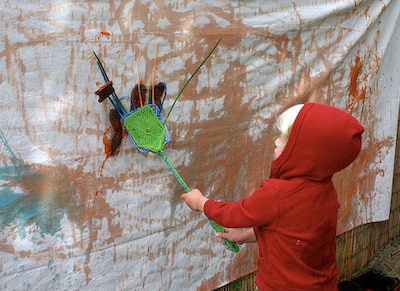Q. My son is naturally inquisitive and questions everything all the time. I worry about keeping him engaged in learning over the summer. He loves water, btw. Any ideas?
A. Drip, plop, splish, trickle, whoosh! There is nothing as delightful, compelling, or endlessly variable as water. Water is irresistible for children, all the way from babies on up – and why not? Children have plenty of experiences with water; they bathe in it, drink it, stomp in puddles, and get wet when it rains. Water is a richly satisfying sensory material, ideal for open-ended play, and offers infinite opportunities to explore science in a fun, active, challenging way.
As fun as plain old water can be, an intentionally and expertly designed environment can take children’s natural fascination with water to the next level of exploration, experimentation and discovery. This summer, the Children’s Museum of Denver will do just that with the special summer exhibit, “Just Add Water.” In “Just Add Water,” children will explore the properties and characteristics of water, investigate flow, and play with complex ideas about buoyancy, density and displacement. They can create a geyser, direct a river, and even paint with this extraordinary substance. “Just Add Water” will provide the tools, access and inspiration for children to focus their spontaneous explorations and their natural drive to experiment with water, and help them notice, question, test, and think creatively about the properties of water.
You can also recreate the fun and learning of “Just Add Water” at home with some simple materials. Try a few of these fun and easy water activities at home this summer for some wet and wild learning.
The cork challenge
Try this brainteaser: Ask your parents if they can place a cork in the middle of a bowl of water and have it stay in the center. Fun-loving folks that they are, they’ll probably take up the challenge, placing the cork ever more carefully in the center of the bowl, only to have it drift to the side again and again.
How to make it work: Very slowly add water to the bowl until the water level actually rises over the rim of the bowl in a wiggly curve (for extra points, explain to your parents that the water is held in place by surface tension). This time, when you gently set the cork in the water, it moves to the bowl’s center, the place where the water level is highest. Since a little water may spill as you do this, you might want to put your bowl on a plate. (If you forget, explain to your parents that you’ve just demonstrated displacement.)
OBSTA-COOL course
If you are planning to water your lawn, you also can set up a get-wet obstacle course with a sprinkler centerpiece. Stations could include drop-kicking a water balloon, jumping rope in the sprinkler spray, shooting a squirt gun at a predetermined target, or any other creatively wet challenges. You can use a stopwatch to keep track of time for each player or run a relay with two teams going through in opposite directions.
Water color painting
This backyard mural project lets you combine the art and cool summertime fun, transforming an old white sheet into a monumental canvas.
How to do it: Start by soaking an old sheet in water and then hanging it on a clothesline or draping it over a fence. Get

out various tempera paints and applicators–sponges, paintbrushes, squirt bottles–and go at it, creating pictures, tic-tac-toe grids or just colorful designs. You can also mute and mix colors with a water-filled spray bottle. Whenever you don’t like what you see, simply hose down the canvas and start over. For art on a smaller scale, try the same techniques with a pillowcase or an old T-shirt.
Frozen fossil dig
First, you’ll need to freeze an animal figure or dinosaur in water in a large plastic container. Then set your young paleontologist to work with metal spoons, forks, (or for older ones – a hammer and screwdriver – and don’t forget eye protection), chipping away at the icy tomb. Be sure to be present when he frees the ancient artifact and discovers that it’s perfectly preserved.
Now, go out there and enjoy the warmer months.
About our First Person series:
First Person is where Chalkbeat features personal essays by educators, students, parents, and others trying to improve public education. Read our submission guidelines here.
